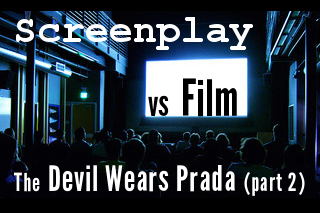Yesterday, I wrote about screenwriting tips I learned from comparing the Devil Wears Prada screenplay to its movie version. Some of the tips concerned how to write lead roles to use as “actorbait” while others showed how you could trim your screenplay by eliminating unnecessary characters and repetition. Here are more screenplay writing tips I learned from this blockbuster movie:
Screenwriting Tip #7: Opt for action over dialogue
Okay, I know that yesterday, in screenwriting tip #3 from the Devil Wears Prada, I advised you to give big speeches to your leads–especially if you’re writing your leading roles as actorbait for A-list talent. But, if a scene with lots of dialogue can be better represented by an action, go with the action.
Below are some examples of how the movie replaced dialogue with action:
Screenplay Example #1:
INT. RUNWAY — DAY
EMILY shows ANDY how to set up for MIRANDA’s arrival. They move between the kitchen, the outer office, and MIRANDA’s office.
EMILY
It must be Pellegrino, frigid, and placed on her right in the 2 o’clock position. These are the only coasters we use, they’re made of zebrawood.
ANDY
Excellent. I don’t know what that is, but it sounds cool.
…EMILY scoops up an armful of magazines.
EMILY
Last thing, the periodicals.
They walk into MIRANDA’s office. EMILY spreads out the magazines on a table.
EMILY
Fanned out with exactly three-quarters of an inch between them.
In the movie, we see Emily hustling to accomplish these very tasks before Miranda arrives to work. Seeing it done, rather than hearing Emily describe it, conveyed the same message much more economically.
Screenplay Example #2:
INT. RESTAURANT — NIGHT
NATE, DOUG and LILY are hanging out with NATE’s friends when ANDY walks in. She runs over, hugs NATE and sits down.
ANDY
I’m so sorry I’m late. One moment Miranda just announces I have to go to the benefit, next thing you know I’m in a crazy getup directing Isaac Mizrahi to the raw bar.
They’re kind of staring, so she tries to wind it down.
ANDY
But the weirdest thing was that Miranda actually acted like a halfway normal human being and…and…
And she can tell she’s blathering.
ANDY
Anyway. I’m really sorry and…I’m sorry.
She grabs a menu.
ANDY
What’s everyone getting?
Just then the WAITRESS walks over with change from the check.
And ANDY realizes. She’s missed the whole dinner.
In the movie, Andy leaves the benefit, and arrives at Nate’s apartment with a cupcake, decorated with a single candle. That action is the equivalent of Andy’s dialogue at the restaurant. Again, same message conveyed with more economy.
Screenplay Example #3:
INT. RECEPTION — DAY
A handsome Italian man, MASSIMO CORTILEONI, steps off the elevator. MIRANDA greets him. They airkiss.
MIRANDA
Massimo! Mio Amore!
MASSIMO
Miranda! Belissima!
He rattles off some more compliments in Italian as she leads him down the hall to her office.
MIRANDA
Oh, Massimo, stop. I’m a married woman you know.
[Editorial note: would Miranda flirt like that?!]
She walks by ANDY and EMILY.
MIRANDA
Andrea, this is Massimo Cortileoni, president of LVMH.
(to MASSIMO)
If you need anything at all, just let Andrea know.
This exchange is a big deal–Andy has supplanted Emily as Miranda’s most trusted assistant. In the movie, this whole power exchange is revealed through a single action: Miranda puts her coat and bag on Emily’s desk for Emily, not Andy, to hang up. That action telegraphs the same information as the speech above between Massimo and Miranda.
After studying these examples, it should be a breeze for you to replace dialogue with action in your own script!
Screenwriting Tip #8: Exploit all opportunities
Miranda is a devil of a boss. That’s well-established in the screenplay…but there were some missed opportunities to show how impossible she was to work for, opportunities which the movie took full advantage of. For example, at Andy’s interview with Miranda, Miranda observes, “Editor-in-Chief of the Daily Northwestern. Impressive.”
This was on page 10 of the screenplay, far too early for Miranda to show any signs of normal human behavior like respecting someone else’s accomplishment. In the movie, it takes forty-five minutes, before Miranda shows Andy even an iota of respect.
In the screenplay, Andy’s allowed to sit down and enjoy her cellulite-filled corn chowder as she chats with Nigel. In the movie, she and Nigel don’t even get to have lunch because Miranda has re-scheduled the run-through meeting.
In the screenplay, when Miranda flies into Miami, Emily issues instructions to Andy, making it very clear that Andy will be on-call to attend to Miranda’s whims, even though Miranda is away. In the movie, Andy excitedly tells Emily about her weekend plans and how great it is Miranda is away on business because they won’t have to take care of Miranda’s demands. When Miranda interrupts Andy’s outing with her dad and insists Andy secures Miranda a flight in the middle of a hurrican, it makes Miranda appear all the more impossible.
We’ve all had bosses who are nightmares (although probably none were as nightmarish as Miranda). That’s the fun of the movie–seeing someone else suffer at the hands of her boss…and eventually having the guts to leave.
We’re going to the movie to see Miranda be the devil incarnate–so every opportunity to showcase Miranda’s impossibly demanding nature should be exploited. Give the audience as much as you can of what they came to see, as long as you don’t sacrifice your story–or your characters–to do it.
Screenwriting Tip #9: Clarify the trajectory of transformation
I know that sounds all New Age-y, so let me do a little clarifying myself. This story is about Andy, and how working for Miranda changes her. It’s about losing herself because of ambition, and finding herself again. In other words, while some of Andy’s changes are shown through her relationships with other people, Andy’s the star of the show.
One of the people who gets lost in the wake of Andy’s ambition is her boyfriend. At the last minute, Andy assists Miranda at a benefit and misses celebrating her boyfriend’s birthday. He’s not happy about it, especially since it’s not the first time Andy has put Miranda’s needs above his. In the screenplay, some scenes prior, in perfect imitation of the way Andy’s been blowing him off, Nate blows off Andy to go play poker with his friends.
Reading that scene was jarring. It took me awhile to figure out why…I think it’s because all of a sudden, the screenplay seemed to be attaching importance to Nate’s choices. But Nate isn’t the one whose story we’ve come to see. It’s Andy’s choices that we want under a microscope, not Nate’s.
It’s a subtle point, and I’m not sure I’ve explained it all that well. Basically, what I’m trying to say is that depending on how a scene is written and where it’s placed, it can come across as being told from the point of view of a character other than your protagonist.
If you’re telling a story with multiple heroes like the Lord of the Rings, that’s all well and good. But if you’re writing a screenplay like the Devil Wears Prada which is told from one person’s point of view–Andy’s–make sure that every scene reads that way.
Screenwriting Tip #10: Crucial beats can’t rely on a celebrity cameo
A few years ago, it was really popular to insert scenes in a screenplay with a celebrity who would play himself. Ben Affleck showed up in the spec screeplay, Brad Cutter Ruined My Life Again, while Christian Bale made a cameo in early drafts of Bridesmaids.
If you’re trying to break into Hollywood, you’re going to have to rely on your screenwriting talent–and your own ability to write funny dialogue and scenes. You can’t use a celebrity cameo as a crutch to prop up your script. For that reason, I’d advise against using celeb cameos. It’s especially unwise to involve a celebrity in a pivotal story event because there’s no guarantee that your hand-picked celeb is available to make his cameo appearance, assuming he’s even interested in doing it.
Much better to write the scene without the celebrity. But if you insist on Alec Baldwin making a surprise appearance in your screenplay, at least think of another way for the pivotal scene to take place without him.
In the Devil Wears Prada script, Elton John (!) made a surprise cameo appearance, at Paris Fashion Week:
ANDY and EMILY are with MIRANDA who is talking to ELTON JOHN.
Suddenly, they’re surprised by the appearance of MIRANDA’S husband, STEPHEN, quite drunk.
MIRANDA
Darling, there you are.
STEPHEN
It’s a banner evening. Three people have failed to recognized me, one person called me Mr Priestly and now the damned bartender refuses to serve me.
Everyone freezes. MIRANDA forces a laugh. EMILY emits a cough of shock, but ANDY quickly turns to ELTON, distracting him.
ANDY
I’m sorry to be such an idot, but I think you are so awesome. I can sing along, to like fifty of your songs…I think Crocodile Rock is my favorite, but I also love Tiny Dancer…
And while she chats with him, MIRANDA, puts her arm around her husband and leads him gently away.
…she turns.
and looks at ANDY.
And MIRANDA mouths the words “thank you.”
Miranda thanking Andy is nothing short of miraculous. It’s a key turning point in the screenplay, so the scene has got to stay–but how to do it sans Elton John? The movie provides the answer: instead of Miranda’s husband embarrassing her in front of Elton John, Mr Priestly embarrasses her in front of Irv Ravitz–Miranda’s boss.
Because of Irv’s importance to Miranda, the scene still retains its intensity, and Andy still looks like a hero, justifying Miranda’s thanks. Bonus: it drew the audience’s attention to Irv, so they’ll remember who he is when his character pops in again to play a crucial role in Act Three.
Screenwriting Tip #11: Alienation is not the end game
The screenplay draft of the Devil Wears Prada included a subplot involving Andy’s father–and at its climax, he has a heart attack while Andy and Miranda are in Paris. Instead of rushing home, Andy continues her assistant duties to Miranda, especially to alert Miranda that she’s about to be ousted for a younger (and French!) editor-in-chief.
Andy chooses Miranda over her own family–a choice that reveals reams about her character. Isn’t that what all the screenwriting guides advise you to do? So why was this subplot abandoned in the movie?
When I read those scenes, on one level, I was impressed by the payoff of so much setup, but on another level, I was completely disgusted with Andy. I knew that working for Miranda had changed her…but to turn her back on her dad when he just had a heart attack?! It was too callous, too cold. And showing Andy’s character transformation in this particular way was too alienating.
When Andy turns her back on her friends and her boyfriend in order to ascend the ranks at Runway, Andy’s still redeemable. But when she turns her back on her potentially dying dad–she’s not. It’s a big difference.
Screenwriting classes and books teach you to reveal character by showcasing your protagonist’s choices–but if you want to maintain audience sympathy and/or empathy for your protagonist, make sure those choices don’t render them unredeemable, a guideline similar to my “don’t kill the dog” rule which I describe in screenwriting tip #2 in 8 Screenwriting Tips from Taken and screenwriting tip #4 in 11 Screenwriting Tips from Salt.
Note: The scale of what’s redeemable or not depends on the kind of movie you’re writing. A hero can kill someone and still be redeemable in a dark, gritty drama. But in a lighthearted workplace comedy with feather boas and Starbucks lattes? Not so much.
Screenwriting Tip #12: Be vigilant about the end of Act Two
On page 85 of the Devil Wears Prada screenplay, right before Andy’s trip to Paris for Fashion Week, we got this scene:
INT. RUNWAY — DAY
ANDY sits in NIGEL’S office as NIGEL and the FASHION ASSISTANTS swirl outfits in front of her.
NIGEL
To accompany Miranda to a bistro? Cuffed, charocal gray Theory pants with a black silk turtleneck by Celine. For the tennis club where she’ll receive private lessons? Bootleg workout pants, zip-up hoodie and tank top, all by Prada Sport. For the front row of the Chanel show? A pleated schoolgirl skirt by Anna Sui with a sheer white Miu Miu blouse and Chanel spectators with a Michael Kors blazer…
A BEAUTY EDITOR appears in front of ANDY with a cosmetic bag.
BEAUTY EDITOR
Here are your shadows, liners, lipsticks in matte, high-shine, long-lasting and clear, six mascaras from light blue to pouty black, eyelash curler and two eyelash combs, liquid, solid and powder blush. And of course your moisturizers: glimmering, tinted, scented, unscented, hypo-allergenic, alpha-hydroxy…
Every scene in your screenplay should advance the plot somehow. This scene doesn’t. It not only doesn’t advance the plot, but it also brings all the momentum of the second act to a screeching halt.
You need to be extra-vigilant about the second half of Act Two. It’s where good screenplays go to die. They get killed by scenes like these–scenes which aren’t necessarily bad, but belong earlier on in the script, when the stakes haven’t been raised so high.
At this stage in your script–the end of Act Two–things are supposed to be falling apart for your hero. That’s what you should focus on. Whatever fragile alliances he’s built up, whatever relationships he holds dear–most, if not all, of these should be ripped to shreds by the end of Act Two. That’s why the second act break is the “all is lost” moment. You should be searching for loose story threads and pulling on them without mercy like a kitten bestowed with Wolverine claws.
Watching a blank screen (with modifications) by Kenneth Lu




















